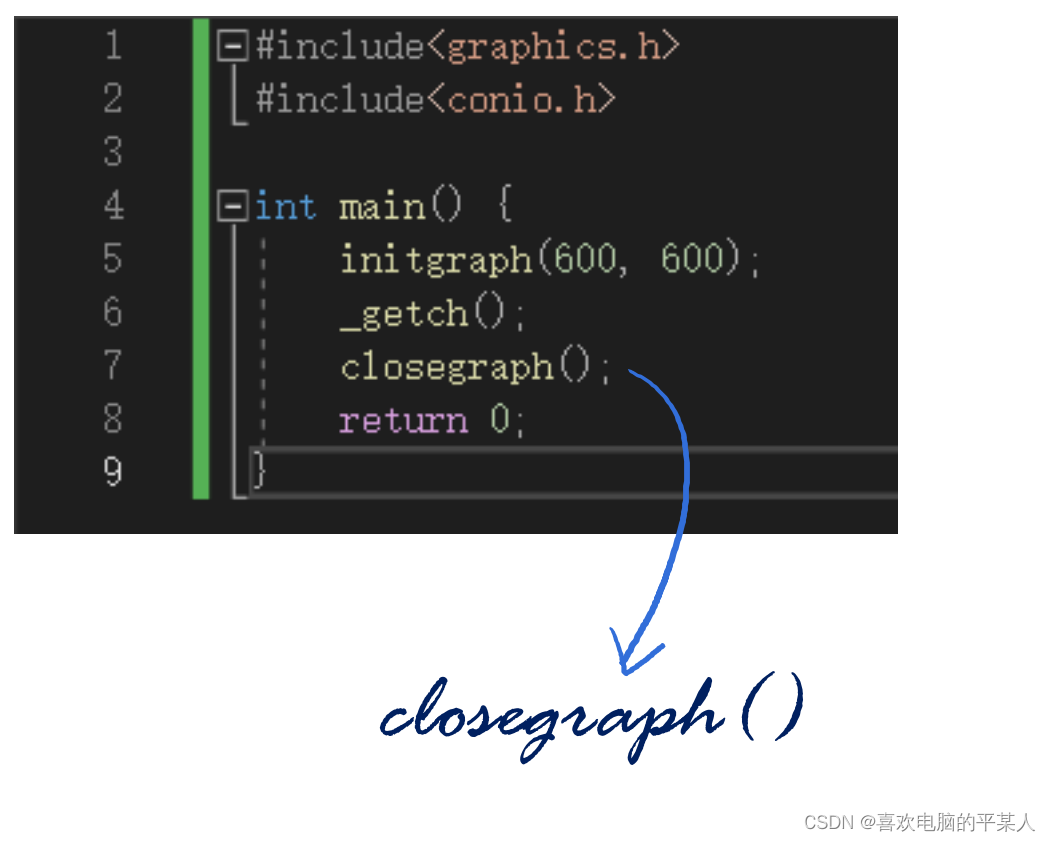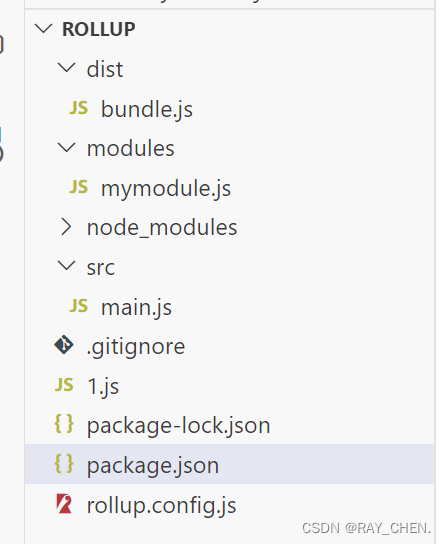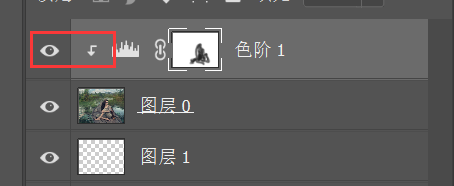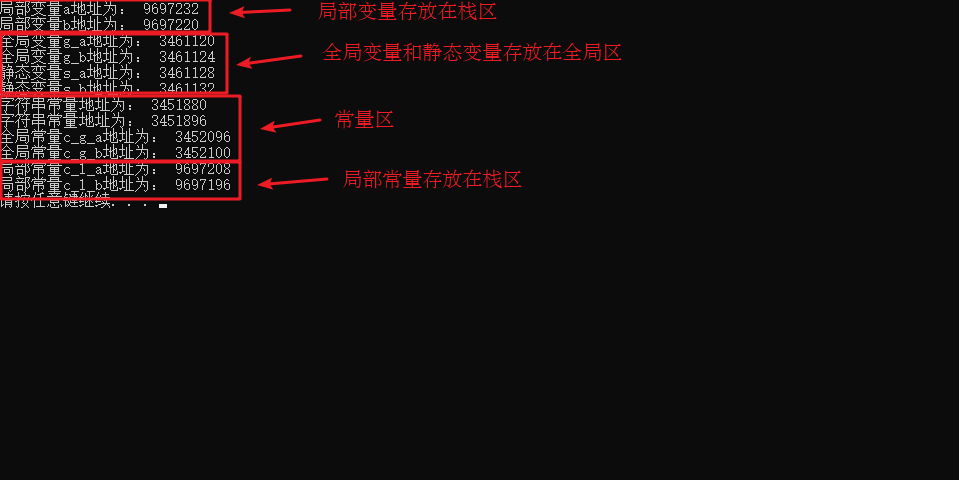一、背景
限流对于一个微服务架构系统来说具有非常重要的意义,否则其中的某个微服务将成为整个系统隐藏的雪崩因素,为什么这么说?
举例来讲,某个SAAS平台有100多个微服务应用,但是作为底层的某个或某几个应用来说,将会被所有上层应用频繁调用,业务高峰期时,如果底层应用不做限流处理,该应用必将面临着巨大的压力,尤其是那些个别被高频调用的接口来说,最直接的表现就是导致后续新进来的请求阻塞、排队、响应超时...最后直到该服务所在JVM资源被耗尽。
二、限流概述
在大多数的微服务架构在设计之初,比如在技术选型阶段,架构师会从一个全局的视角去规划技术栈的组合,比如结合当前产品的现状考虑是使用dubbo?还是springcloud?作为微服务治理的底层框架。甚至为了满足快速的上线、迭代和交付,直接以springboot为基座进行开发,后续再引入新的技术栈等...
所以在谈论某个业务场景具体的技术解决方案时不可一概而论,而是需要结合产品和业务的现状综合评估,以限流来说,在下面的不同的技术架构下具体在选择的时候可能也不一样。
2.1 dubbo 服务治理模式
选择dubbo框架作为基础服务治理对于那种偏向内部平台的应用还是不错的,dubbo底层走netty,这一点相比http协议来说,在一定场景下还是具有优势的,如果选择dubbo,在选择限流方案上可以做如下的参考。
2.1.1 dubbo框架级限流
dubbo官方提供了完善的服务治理,能够满足大多数开发场景中的需求,针对限流这个场景,具体来说包括如下手段,具体的配置,可以参考官方手册;
客户端限流
- 信号量限流 (通过统计的方式)
- 连接数限流 (socket->tcp)
服务端限流
- 线程池限流 (隔离手段)
- 信号量限流 (非隔离手段)
- 接收数限流 (socket->tcp)
2.1.2 线程池设置
多线程并发操作一定离不开线程池,Dubbo自身提供了支持了四种线程池类型支持。生产者<dubbo:protocol>标签中可配置线程池关键参数,线程池类型、阻塞队列大小、核心线程数量等,通过配置生产端的线程池数量可以在一定程度上起到限流的效果。
2.1.3 集成第三方组件
如果是springboot框架的项目,可以考虑直接引入地方的组件或SDK,比如hystrix,guava,sentinel原生SDK等,如果技术实力足够强甚至可以考虑自己造轮子。
2.2 springcloud 服务治理模式
如果你的服务治理框架选用的是springcloud或springcloud-alibaba,其框架自身的生态中已经包含了相应的限流组件,可以实现开箱即用,下面列举几种常用的基于springcloud框架的限流组件。
2.2.1 hystrix
Hystrix是Netflix开源的一款容错框架,在springcloud早期推出市场的时候,作为springcloud生态中用于限流、熔断、降级的一款组件。
Hystrix提供了限流功能,在springcloud架构的系统中,可以在网关启用Hystrix,进行限流处理,每个微服务也可以各自启用Hystrix进行限流。
Hystrix默认使用线程隔离模式,可以通过线程数+队列大小进行限流,具体参数配置可以参考官网相关资料。
2.2.2 sentinel
Sentinel 号称分布式系统的流量防卫兵,属于springcloud-alibaba生态中的重要组件,面向分布式服务架构的流量控制组件,主要以流量为切入点,从限流、流量整形、熔断降级、系统负载保护、热点防护等多个维度来帮助开发者保障微服务的稳定性。
2.3 网关层限流
随着微服务规模的增加,整个系统中很多微服务都需要实现限流这种需求时,就可以考虑在网关这一层进行限流了,通常来说,网关层的限流面向的是通用的业务,比如那些恶意的请求,爬虫,攻击等,简单来说,网关层面的限流提供了一层对系统整体的保护措施。
三、常用限流策略
3.1 限流常用的算法
不管是哪种限流组件,其底层的限流实现算法大同小异,这里列举几种常用的限流算法以供了解。
3.1.1 令牌桶算法
令牌桶算法是目前应用最为广泛的限流算法,顾名思义,它有以下两个关键角色:
- 令牌 :获取到令牌的Request才会被处理,其他Requests要么排队要么被直接丢弃;
- 桶 :用来装令牌的地方,所有Request都从这个桶里面获取令牌

令牌桶主要涉及到2个过程,即令牌的生成,令牌的获取
3.1.2 漏桶算法
漏桶算法的前半段和令牌桶类似,但是操作的对象不同,结合下图进行理解。
令牌桶是将令牌放入桶里,而漏桶是将访问请求的数据包放到桶里。同样的是,如果桶满了,那么后面新来的数据包将被丢弃。

3.1.3 滑动时间窗口
根据下图,简单描述下滑动时间窗口这种过程:
-
黑色大框为时间窗口,可以设定窗口时间单位为5秒,它会随着时间推移向后滑动。我们将窗口内的时间划分为五个小格子,每个格子代表1秒钟,同时这个格子还包含一个计数器,用来计算在当前时间内访问的请求数量。那么这个时间窗口内的总访问量就是所有格子计数器累加后的数值;
-
比如说,我们在每一秒内有5个用户访问,第5秒内有10个用户访问,那么在0到5秒这个时间窗口内访问量就是15。如果我们的接口设置了时间窗口内访问上限是20,那么当时间到第六秒的时候,这个时间窗口内的计数总和就变成了10,因为1秒的格子已经退出了时间窗口,因此在第六秒内可以接收的访问量就是20-10=10个;

滑动窗口其实也是一种计算器算法,它有一个显著特点,当时间窗口的跨度越长时,限流效果就越平滑。打个比方,如果当前时间窗口只有两秒,而访问请求全部集中在第一秒的时候,当时间向后滑动一秒后,当前窗口的计数量将发生较大的变化,拉长时间窗口可以降低这种情况的发生概率
四、通用限流实现方案
抛开网关层的限流先不说,在微服务应用中,考虑到技术栈的组合,团队人员的开发水平,以及易维护性等因素,一个比较通用的做法是,利用AOP技术+自定义注解实现对特定的方法或接口进行限流,下面基于这个思路来分别介绍下几种常用的限流方案的实现。
4.1 基于guava限流实现
guava为谷歌开源的一个比较实用的组件,利用这个组件可以帮助开发人员完成常规的限流操作,接下来看具体的实现步骤。
4.1.1 引入guava依赖
版本可以选择更高的或其他版本
<dependency>
<groupId>com.google.guava</groupId>
<artifactId>guava</artifactId>
<version>23.0</version>
</dependency>4.1.2 自定义限流注解
自定义一个限流用的注解,后面在需要限流的方法或接口上面只需添加该注解即可;
import java.lang.annotation.ElementType;
import java.lang.annotation.Retention;
import java.lang.annotation.RetentionPolicy;
import java.lang.annotation.Target;
@Target(value = ElementType.METHOD)
@Retention(value = RetentionPolicy.RUNTIME)
public @interface RateConfigAnno {
String limitType();
double limitCount() default 5d;
}4.1.3 限流AOP类
通过AOP前置通知的方式拦截添加了上述自定义限流注解的方法,解析注解中的属性值,并以该属性值作为guava提供的限流参数,该类为整个实现的核心所在。
import com.alibaba.fastjson2.JSONObject;
import com.google.common.util.concurrent.RateLimiter;
import org.aspectj.lang.JoinPoint;
import org.aspectj.lang.annotation.Aspect;
import org.aspectj.lang.annotation.Before;
import org.slf4j.Logger;
import org.slf4j.LoggerFactory;
import org.springframework.stereotype.Component;
import org.springframework.web.context.request.RequestContextHolder;
import org.springframework.web.context.request.ServletRequestAttributes;
import javax.servlet.ServletOutputStream;
import javax.servlet.http.HttpServletResponse;
import java.io.IOException;
import java.lang.reflect.Method;
import java.util.Objects;
@Aspect
@Component
public class GuavaLimitAop {
private static Logger logger = LoggerFactory.getLogger(GuavaLimitAop.class);
@Before("execution(@RateConfigAnno * *(..))")
public void limit(JoinPoint joinPoint) {
//1、获取当前的调用方法
Method currentMethod = getCurrentMethod(joinPoint);
if (Objects.isNull(currentMethod)) {
return;
}
//2、从方法注解定义上获取限流的类型
String limitType = currentMethod.getAnnotation(RateConfigAnno.class).limitType();
double limitCount = currentMethod.getAnnotation(RateConfigAnno.class).limitCount();
//使用guava的令牌桶算法获取一个令牌,获取不到先等待
RateLimiter rateLimiter = RateLimitHelper.getRateLimiter(limitType, limitCount);
boolean b = rateLimiter.tryAcquire();
if (b) {
System.out.println("获取到令牌");
}else {
HttpServletResponse resp = ((ServletRequestAttributes) RequestContextHolder.getRequestAttributes()).getResponse();
JSONObject jsonObject=new JSONObject();
jsonObject.put("success",false);
jsonObject.put("msg","限流中");
try {
output(resp, jsonObject.toJSONString());
}catch (Exception e){
logger.error("error,e:{}",e);
}
}
}
private Method getCurrentMethod(JoinPoint joinPoint) {
Method[] methods = joinPoint.getTarget().getClass().getMethods();
Method target = null;
for (Method method : methods) {
if (method.getName().equals(joinPoint.getSignature().getName())) {
target = method;
break;
}
}
return target;
}
public void output(HttpServletResponse response, String msg) throws IOException {
response.setContentType("application/json;charset=UTF-8");
ServletOutputStream outputStream = null;
try {
outputStream = response.getOutputStream();
outputStream.write(msg.getBytes("UTF-8"));
} catch (IOException e) {
e.printStackTrace();
} finally {
outputStream.flush();
outputStream.close();
}
}
}其中限流的核心API即为RateLimiter这个对象,涉及到的RateLimitHelper类如下
import com.google.common.util.concurrent.RateLimiter;
import java.util.HashMap;
import java.util.Map;
public class RateLimitHelper {
private RateLimitHelper(){}
private static Map<String,RateLimiter> rateMap = new HashMap<>();
public static RateLimiter getRateLimiter(String limitType,double limitCount ){
RateLimiter rateLimiter = rateMap.get(limitType);
if(rateLimiter == null){
rateLimiter = RateLimiter.create(limitCount);
rateMap.put(limitType,rateLimiter);
}
return rateLimiter;
}
}4.1.4 测试接口
下面添加一个测试接口,测试一下上面的代码是否生效
@RestController
public class OrderController {
//localhost:8081/save
@GetMapping("/save")
@RateConfigAnno(limitType = "saveOrder",limitCount = 1)
public String save(){
return "success";
}
}在接口中为了模拟出效果,我们将参数设置的非常小,即QPS为1,可以预想当每秒请求超过1时将会出现被限流的提示,启动工程并验证接口,每秒1次的请求,可以正常得到结果,效果如下:

快速刷接口,将会看到下面的效果

4.2 基于sentinel限流实现
在不少同学的意识中,sentinel通常是需要结合springcloud-alibaba框架一起实用的,而且与框架集成之后,可以配合控制台一起使用达到更好的效果,实际上,sentinel官方也提供了相对原生的SDK可供使用,接下来就以这种方式进行整合。
4.2.1 引入sentinel核心依赖包
<dependency>
<groupId>com.alibaba.csp</groupId>
<artifactId>sentinel-core</artifactId>
<version>1.8.0</version>
</dependency>4.2.2 自定义限流注解
可以根据需要,添加更多的属性
import java.lang.annotation.ElementType;
import java.lang.annotation.Retention;
import java.lang.annotation.RetentionPolicy;
import java.lang.annotation.Target;
@Target(value = ElementType.METHOD)
@Retention(value = RetentionPolicy.RUNTIME)
public @interface SentinelLimitAnnotation {
String resourceName();
int limitCount() default 5;
}4.2.3 自定义AOP类实现限流
该类的实现思路与上述使用guava类似,不同的是,这里使用的是sentinel原生的限流相关的API,对此不够属性的可以查阅官方的文档进行学习,这里就不展开来说了。
import com.alibaba.csp.sentinel.Entry;
import com.alibaba.csp.sentinel.SphU;
import com.alibaba.csp.sentinel.Tracer;
import com.alibaba.csp.sentinel.slots.block.BlockException;
import com.alibaba.csp.sentinel.slots.block.RuleConstant;
import com.alibaba.csp.sentinel.slots.block.flow.FlowRule;
import com.alibaba.csp.sentinel.slots.block.flow.FlowRuleManager;
import org.apache.commons.lang3.StringUtils;
import org.aspectj.lang.JoinPoint;
import org.aspectj.lang.ProceedingJoinPoint;
import org.aspectj.lang.annotation.Around;
import org.aspectj.lang.annotation.Aspect;
import org.aspectj.lang.annotation.Pointcut;
import org.springframework.stereotype.Component;
import java.lang.reflect.Method;
import java.util.ArrayList;
import java.util.List;
import java.util.Objects;
@Aspect
@Component
public class SentinelMethodLimitAop {
private static void initFlowRule(String resourceName,int limitCount) {
List<FlowRule> rules = new ArrayList<>();
FlowRule rule = new FlowRule();
//设置受保护的资源
rule.setResource(resourceName);
//设置流控规则 QPS
rule.setGrade(RuleConstant.FLOW_GRADE_QPS);
//设置受保护的资源阈值
rule.setCount(limitCount);
rules.add(rule);
//加载配置好的规则
FlowRuleManager.loadRules(rules);
}
@Pointcut(value = "@annotation(com.congge.sentinel.SentinelLimitAnnotation)")
public void rateLimit() {
}
@Around("rateLimit()")
public Object around(ProceedingJoinPoint joinPoint) {
//1、获取当前的调用方法
Method currentMethod = getCurrentMethod(joinPoint);
if (Objects.isNull(currentMethod)) {
return null;
}
//2、从方法注解定义上获取限流的类型
String resourceName = currentMethod.getAnnotation(SentinelLimitAnnotation.class).resourceName();
if(StringUtils.isEmpty(resourceName)){
throw new RuntimeException("资源名称为空");
}
int limitCount = currentMethod.getAnnotation(SentinelLimitAnnotation.class).limitCount();
initFlowRule(resourceName,limitCount);
Entry entry = null;
Object result = null;
try {
entry = SphU.entry(resourceName);
try {
result = joinPoint.proceed();
} catch (Throwable throwable) {
throwable.printStackTrace();
}
} catch (BlockException ex) {
// 资源访问阻止,被限流或被降级
// 在此处进行相应的处理操作
System.out.println("blocked");
return "被限流了";
} catch (Exception e) {
Tracer.traceEntry(e, entry);
} finally {
if (entry != null) {
entry.exit();
}
}
return result;
}
private Method getCurrentMethod(JoinPoint joinPoint) {
Method[] methods = joinPoint.getTarget().getClass().getMethods();
Method target = null;
for (Method method : methods) {
if (method.getName().equals(joinPoint.getSignature().getName())) {
target = method;
break;
}
}
return target;
}
}4.2.4 自定义测试接口
为了模拟效果,这里将QPS的数量设置为1
//localhost:8081/limit
@GetMapping("/limit")
@SentinelLimitAnnotation(limitCount = 1,resourceName = "sentinelLimit")
public String sentinelLimit(){
return "sentinelLimit";
}启动工程之后,浏览器调用接口测试一下,每秒一个请求,可以正常通过

快速刷接口,超过每秒1次时,效果如下

这里只是为了演示出效果,建议在真实的项目中使用时,对返回结果做一个封装。
4.3 基于redis+lua限流实现
redis是线程安全的,天然具有线程安全的特性,支持原子性操作,限流服务不仅需要承接超高QPS,还要保证限流逻辑的执行层面具备线程安全的特性,利用Redis这些特性做限流,既能保证线程安全,也能保证性能。基于redis的限流实现完整流程如下图:
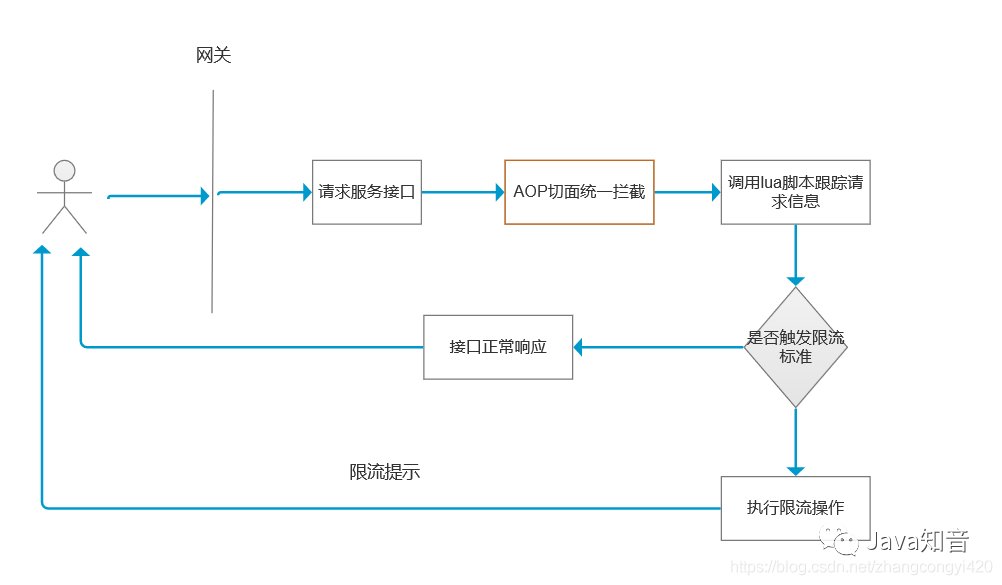
结合上面的流程图,这里梳理出一个整体的实现思路:
-
编写lua脚本,指定入参的限流规则,比如对特定的接口限流时,可以根据某个或几个参数进行判定,调用该接口的请求,在一定的时间窗口内监控请求次数;
-
既然是限流,最好能够通用,可将限流规则应用到任何接口上,那么最合适的方式就是通过自定义注解形式切入;
-
提供一个配置类,被spring的容器管理,redisTemplate中提供了DefaultRedisScript这个bean;
-
提供一个能动态解析接口参数的类,根据接口参数进行规则匹配后触发限流;
4.3.1 引入redis依赖
<dependency>
<groupId>org.springframework.boot</groupId>
<artifactId>spring-boot-starter-data-redis</artifactId>
</dependency>4.3.2 自定义注解
@Target({ElementType.METHOD, ElementType.TYPE})
@Retention(RetentionPolicy.RUNTIME)
@Inherited
@Documented
public @interface RedisLimitAnnotation {
/**
* key
*/
String key() default "";
/**
* Key的前缀
*/
String prefix() default "";
/**
* 一定时间内最多访问次数
*/
int count();
/**
* 给定的时间范围 单位(秒)
*/
int period();
/**
* 限流的类型(用户自定义key或者请求ip)
*/
LimitType limitType() default LimitType.CUSTOMER;
}4.3.3 自定义redis配置类
import org.springframework.context.annotation.Bean;
import org.springframework.core.io.ClassPathResource;
import org.springframework.data.redis.connection.RedisConnectionFactory;
import org.springframework.data.redis.core.RedisTemplate;
import org.springframework.data.redis.core.script.DefaultRedisScript;
import org.springframework.data.redis.serializer.Jackson2JsonRedisSerializer;
import org.springframework.data.redis.serializer.StringRedisSerializer;
import org.springframework.scripting.support.ResourceScriptSource;
import org.springframework.stereotype.Component;
import java.io.Serializable;
@Component
public class RedisConfiguration {
@Bean
public DefaultRedisScript<Number> redisluaScript() {
DefaultRedisScript<Number> redisScript = new DefaultRedisScript<>();
redisScript.setScriptSource(new ResourceScriptSource(new ClassPathResource("limit.lua")));
redisScript.setResultType(Number.class);
return redisScript;
}
@Bean("redisTemplate")
public RedisTemplate<String, Object> redisTemplate(RedisConnectionFactory redisConnectionFactory) {
RedisTemplate<String, Object> redisTemplate = new RedisTemplate<>();
redisTemplate.setConnectionFactory(redisConnectionFactory);
Jackson2JsonRedisSerializer jackson2JsonRedisSerializer = new Jackson2JsonRedisSerializer(Object.class);
//设置value的序列化方式为JSOn
redisTemplate.setValueSerializer(jackson2JsonRedisSerializer);
//设置key的序列化方式为String
redisTemplate.setKeySerializer(new StringRedisSerializer());
redisTemplate.setHashKeySerializer(new StringRedisSerializer());
redisTemplate.setHashValueSerializer(jackson2JsonRedisSerializer);
redisTemplate.afterPropertiesSet();
return redisTemplate;
}
}4.3.4 自定义限流AOP类
import org.aspectj.lang.ProceedingJoinPoint;
import org.aspectj.lang.annotation.Around;
import org.aspectj.lang.annotation.Aspect;
import org.aspectj.lang.annotation.Pointcut;
import org.aspectj.lang.reflect.MethodSignature;
import org.slf4j.Logger;
import org.slf4j.LoggerFactory;
import org.springframework.beans.factory.annotation.Autowired;
import org.springframework.context.annotation.Configuration;
import org.springframework.data.redis.core.RedisTemplate;
import org.springframework.data.redis.core.script.DefaultRedisScript;
import org.springframework.web.context.request.RequestContextHolder;
import org.springframework.web.context.request.ServletRequestAttributes;
import javax.servlet.http.HttpServletRequest;
import java.io.Serializable;
import java.lang.reflect.Method;
import java.util.Collections;
import java.util.List;
@Aspect
@Configuration
public class LimitRestAspect {
private static final Logger logger = LoggerFactory.getLogger(LimitRestAspect.class);
@Autowired
private RedisTemplate<String, Object> redisTemplate;
@Autowired
private DefaultRedisScript<Number> redisluaScript;
@Pointcut(value = "@annotation(com.congge.config.limit.RedisLimitAnnotation)")
public void rateLimit() {
}
@Around("rateLimit()")
public Object interceptor(ProceedingJoinPoint joinPoint) throws Throwable {
MethodSignature signature = (MethodSignature) joinPoint.getSignature();
Method method = signature.getMethod();
Class<?> targetClass = method.getDeclaringClass();
RedisLimitAnnotation rateLimit = method.getAnnotation(RedisLimitAnnotation.class);
if (rateLimit != null) {
HttpServletRequest request = ((ServletRequestAttributes) RequestContextHolder.getRequestAttributes()).getRequest();
String ipAddress = getIpAddr(request);
StringBuffer stringBuffer = new StringBuffer();
stringBuffer.append(ipAddress).append("-")
.append(targetClass.getName()).append("- ")
.append(method.getName()).append("-")
.append(rateLimit.key());
List<String> keys = Collections.singletonList(stringBuffer.toString());
//调用lua脚本,获取返回结果,这里即为请求的次数
Number number = redisTemplate.execute(
redisluaScript,
keys,
rateLimit.count(),
rateLimit.period()
);
if (number != null && number.intValue() != 0 && number.intValue() <= rateLimit.count()) {
logger.info("限流时间段内访问了第:{} 次", number.toString());
return joinPoint.proceed();
}
} else {
return joinPoint.proceed();
}
throw new RuntimeException("访问频率过快,被限流了");
}
/**
* 获取请求的IP方法
* @param request
* @return
*/
private static String getIpAddr(HttpServletRequest request) {
String ipAddress = null;
try {
ipAddress = request.getHeader("x-forwarded-for");
if (ipAddress == null || ipAddress.length() == 0 || "unknown".equalsIgnoreCase(ipAddress)) {
ipAddress = request.getHeader("Proxy-Client-IP");
}
if (ipAddress == null || ipAddress.length() == 0 || "unknown".equalsIgnoreCase(ipAddress)) {
ipAddress = request.getHeader("WL-Proxy-Client-IP");
}
if (ipAddress == null || ipAddress.length() == 0 || "unknown".equalsIgnoreCase(ipAddress)) {
ipAddress = request.getRemoteAddr();
}
// 对于通过多个代理的情况,第一个IP为客户端真实IP,多个IP按照','分割
if (ipAddress != null && ipAddress.length() > 15) {
if (ipAddress.indexOf(",") > 0) {
ipAddress = ipAddress.substring(0, ipAddress.indexOf(","));
}
}
} catch (Exception e) {
ipAddress = "";
}
return ipAddress;
}
}该类要做的事情和上面的两种限流措施类似,不过在这里核心的限流是通过读取lua脚步,通过参数传递给lua脚步实现的。
4.3.5 自定义lua脚本
在工程的resources目录下,添加如下的lua脚本
local key = "rate.limit:" .. KEYS[1]
local limit = tonumber(ARGV[1])
local current = tonumber(redis.call('get', key) or "0")
if current + 1 > limit then
return 0
else
-- 没有超阈值,将当前访问数量+1,并设置2秒过期(可根据自己的业务情况调整)
redis.call("INCRBY", key,"1")
redis.call("expire", key,"2")
return current + 1
end4.3.6 添加测试接口
@RestController
public class RedisController {
//localhost:8081/redis/limit
@GetMapping("/redis/limit")
@RedisLimitAnnotation(key = "queryFromRedis",period = 1, count = 1)
public String queryFromRedis(){
return "success";
}
}为了模拟效果,这里将QPS设置为1 ,启动工程后(提前启动redis服务),调用一下接口,正常的效果如下:

快速刷接口,超过每秒1次的请求时看到如下效果

五、自定义starter限流实现
上面通过案例介绍了几种常用的限流实现,不过细心的同学可以看到,这些限流的实现都是在具体的工程模块中嵌入的,事实上,在真实的微服务开发中,一个项目可能包含了众多的微服务模块,为了减少重复造轮子,避免每个微服务模块中单独实现,可以考虑将限流的逻辑实现封装成一个SDK,即作为一个springboot的starter的方式被其他微服务模块进行引用即可。这也是目前很多生产实践中比较通用的做法,接下来看看具体的实现吧。
5.1 前置准备
创建一个空的springboot工程,工程目录结构如下图,目录说明:
-
annotation:存放自定义的限流相关的注解; -
aop:存放不同的限流实现,比如基于guava的aop,基于sentinel的aop实现等; -
spring.factories:自定义待装配的aop实现类;
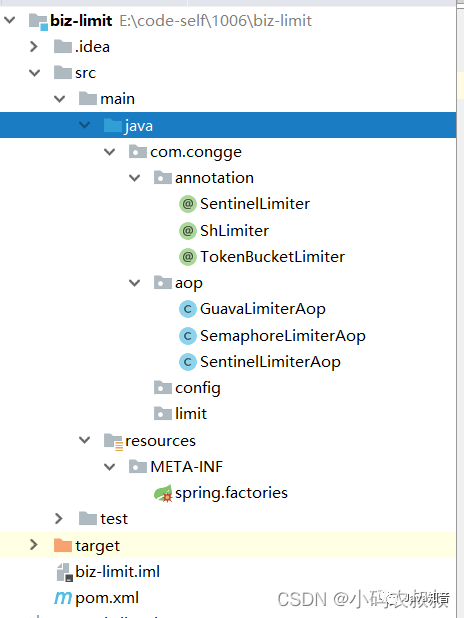
5.2 代码整合完成步骤
5.2.1 导入基础的依赖
这里包括如下几个必须的依赖,其他的依赖可以结合自身的情况合理选择;
- spring-boot-starter;
- guava;
- spring-boot-autoconfigure;
- sentinel-core;
<parent>
<groupId>org.springframework.boot</groupId>
<artifactId>spring-boot-starter-parent</artifactId>
<version>2.2.1.RELEASE</version>
<relativePath/>
</parent>
<properties>
<project.build.sourceEncoding>UTF-8</project.build.sourceEncoding>
<project.reporting.outputEncoding>UTF-8</project.reporting.outputEncoding>
<java.version>1.8</java.version>
</properties>
<dependencies>
<dependency>
<groupId>org.springframework.boot</groupId>
<artifactId>spring-boot-starter-aop</artifactId>
</dependency>
<dependency>
<groupId>log4j</groupId>
<artifactId>log4j</artifactId>
<version>1.2.17</version>
</dependency>
<dependency>
<groupId>org.springframework.boot</groupId>
<artifactId>spring-boot-starter</artifactId>
</dependency>
<dependency>
<groupId>org.springframework.boot</groupId>
<artifactId>spring-boot-starter-web</artifactId>
</dependency>
<dependency>
<groupId>org.projectlombok</groupId>
<artifactId>lombok</artifactId>
</dependency>
<!-- guava-->
<dependency>
<groupId>com.google.guava</groupId>
<artifactId>guava</artifactId>
<version>23.0</version>
</dependency>
<dependency>
<groupId>org.springframework.boot</groupId>
<artifactId>spring-boot-autoconfigure</artifactId>
<version>2.2.1.RELEASE</version>
</dependency>
<dependency>
<groupId>org.springframework.boot</groupId>
<artifactId>spring-boot-configuration-processor</artifactId>
<version>2.2.1.RELEASE</version>
</dependency>
<dependency>
<groupId>com.alibaba.csp</groupId>
<artifactId>sentinel-core</artifactId>
<version>1.8.0</version>
</dependency>
<dependency>
<groupId>org.apache.commons</groupId>
<artifactId>commons-lang3</artifactId>
<version>3.4</version>
</dependency>
<dependency>
<groupId>com.alibaba.fastjson2</groupId>
<artifactId>fastjson2</artifactId>
<version>2.0.22</version>
</dependency>
</dependencies>
<build>
<resources>
<resource>
<directory>src/main/resources</directory>
<includes>
<include>**/**</include>
</includes>
</resource>
</resources>
</build>5.2.2 自定义注解
目前该SDK支持三种限流方式,即后续其他微服务工程中可以通过添加这3种注解即可实现限流,分别是基于guava的令牌桶,基于sentinel的限流,基于java自带的Semaphore限流,三个自定义注解类如下:
令牌桶
@Documented
@Target(ElementType.METHOD)
@Retention(RetentionPolicy.RUNTIME)
public @interface TokenBucketLimiter {
int value() default 50;
}Semaphore
@Documented
@Target(ElementType.METHOD)
@Retention(RetentionPolicy.RUNTIME)
public @interface ShLimiter {
int value() default 50;
}sentinel
@Target(value = ElementType.METHOD)
@Retention(value = RetentionPolicy.RUNTIME)
public @interface SentinelLimiter {
String resourceName();
int limitCount() default 50;
}5.2.3 限流实现AOP类
具体的限流在AOP中进行实现,思路和上一章节类似,即通过环绕通知的方式,先解析那些添加了限流注解的方法,然后解析里面的参数,进行限流的业务实现。
基于guava的aop实现
import com.alibaba.fastjson2.JSONObject;
import com.congge.annotation.TokenBucketLimiter;
import com.google.common.util.concurrent.RateLimiter;
import lombok.extern.slf4j.Slf4j;
import org.aspectj.lang.ProceedingJoinPoint;
import org.aspectj.lang.annotation.Around;
import org.aspectj.lang.annotation.Aspect;
import org.aspectj.lang.annotation.Pointcut;
import org.springframework.cglib.core.ReflectUtils;
import org.springframework.stereotype.Component;
import org.springframework.web.context.request.RequestContextHolder;
import org.springframework.web.context.request.ServletRequestAttributes;
import javax.servlet.ServletOutputStream;
import javax.servlet.http.HttpServletResponse;
import java.io.IOException;
import java.lang.reflect.Method;
import java.util.Arrays;
import java.util.Map;
import java.util.concurrent.ConcurrentHashMap;
@Aspect
@Component
@Slf4j
public class GuavaLimiterAop {
private final Map<String, RateLimiter> rateLimiters = new ConcurrentHashMap<String, RateLimiter>();
@Pointcut("@annotation(com.congge.annotation.TokenBucketLimiter)")
public void aspect() {
}
@Around(value = "aspect()")
public Object around(ProceedingJoinPoint point) throws Throwable {
log.debug("准备限流");
Object target = point.getTarget();
String targetName = target.getClass().getName();
String methodName = point.getSignature().getName();
Object[] arguments = point.getArgs();
Class<?> targetClass = Class.forName(targetName);
Class<?>[] argTypes = ReflectUtils.getClasses(arguments);
Method method = targetClass.getDeclaredMethod(methodName, argTypes);
// 获取目标method上的限流注解@Limiter
TokenBucketLimiter limiter = method.getAnnotation(TokenBucketLimiter.class);
RateLimiter rateLimiter = null;
Object result = null;
if (null != limiter) {
// 以 class + method + parameters为key,避免重载、重写带来的混乱
String key = targetName + "." + methodName + Arrays.toString(argTypes);
rateLimiter = rateLimiters.get(key);
if (null == rateLimiter) {
// 获取限定的流量
// 为了防止并发
rateLimiters.putIfAbsent(key, RateLimiter.create(limiter.value()));
rateLimiter = rateLimiters.get(key);
}
boolean b = rateLimiter.tryAcquire();
if(b){
log.debug("得到令牌,准备执行业务");
result = point.proceed();
}else {
HttpServletResponse resp = ((ServletRequestAttributes) RequestContextHolder.getRequestAttributes()).getResponse();
JSONObject jsonObject=new JSONObject();
jsonObject.put("success",false);
jsonObject.put("msg","限流中");
try {
output(resp, jsonObject.toJSONString());
}catch (Exception e){
log.error("error,e:{}",e);
}
}
} else {
result = point.proceed();
}
log.debug("退出限流");
return result;
}
public void output(HttpServletResponse response, String msg) throws IOException {
response.setContentType("application/json;charset=UTF-8");
ServletOutputStream outputStream = null;
try {
outputStream = response.getOutputStream();
outputStream.write(msg.getBytes("UTF-8"));
} catch (IOException e) {
e.printStackTrace();
} finally {
outputStream.flush();
outputStream.close();
}
}
}基于Semaphore的aop实现
import com.congge.annotation.ShLimiter;
import lombok.extern.slf4j.Slf4j;
import org.aspectj.lang.ProceedingJoinPoint;
import org.aspectj.lang.annotation.Around;
import org.aspectj.lang.annotation.Aspect;
import org.aspectj.lang.annotation.Pointcut;
import org.slf4j.Logger;
import org.slf4j.LoggerFactory;
import org.springframework.cglib.core.ReflectUtils;
import org.springframework.stereotype.Component;
import java.lang.reflect.Method;
import java.util.Arrays;
import java.util.Map;
import java.util.concurrent.ConcurrentHashMap;
import java.util.concurrent.Semaphore;
@Aspect
@Component
@Slf4j
public class SemaphoreLimiterAop {
private final Map<String, Semaphore> semaphores = new ConcurrentHashMap<String, Semaphore>();
private final static Logger LOG = LoggerFactory.getLogger(SemaphoreLimiterAop.class);
@Pointcut("@annotation(com.congge.annotation.ShLimiter)")
public void aspect() {
}
@Around(value = "aspect()")
public Object around(ProceedingJoinPoint point) throws Throwable {
log.debug("进入限流aop");
Object target = point.getTarget();
String targetName = target.getClass().getName();
String methodName = point.getSignature().getName();
Object[] arguments = point.getArgs();
Class<?> targetClass = Class.forName(targetName);
Class<?>[] argTypes = ReflectUtils.getClasses(arguments);
Method method = targetClass.getDeclaredMethod(methodName, argTypes);
// 获取目标method上的限流注解@Limiter
ShLimiter limiter = method.getAnnotation(ShLimiter.class);
Object result = null;
if (null != limiter) {
// 以 class + method + parameters为key,避免重载、重写带来的混乱
String key = targetName + "." + methodName + Arrays.toString(argTypes);
// 获取限定的流量
Semaphore semaphore = semaphores.get(key);
if (null == semaphore) {
semaphores.putIfAbsent(key, new Semaphore(limiter.value()));
semaphore = semaphores.get(key);
}
try {
semaphore.acquire();
result = point.proceed();
} finally {
if (null != semaphore) {
semaphore.release();
}
}
} else {
result = point.proceed();
}
log.debug("退出限流");
return result;
}
}基于sentinel的aop实现
import com.alibaba.csp.sentinel.Entry;
import com.alibaba.csp.sentinel.SphU;
import com.alibaba.csp.sentinel.Tracer;
import com.alibaba.csp.sentinel.slots.block.BlockException;
import com.alibaba.csp.sentinel.slots.block.RuleConstant;
import com.alibaba.csp.sentinel.slots.block.flow.FlowRule;
import com.alibaba.csp.sentinel.slots.block.flow.FlowRuleManager;
import com.congge.annotation.SentinelLimiter;
import org.apache.commons.lang3.StringUtils;
import org.aspectj.lang.JoinPoint;
import org.aspectj.lang.ProceedingJoinPoint;
import org.aspectj.lang.annotation.Around;
import org.aspectj.lang.annotation.Aspect;
import org.aspectj.lang.annotation.Pointcut;
import org.springframework.stereotype.Component;
import java.lang.reflect.Method;
import java.util.ArrayList;
import java.util.List;
import java.util.Objects;
@Aspect
@Component
public class SentinelLimiterAop {
private static void initFlowRule(String resourceName,int limitCount) {
List<FlowRule> rules = new ArrayList<>();
FlowRule rule = new FlowRule();
//设置受保护的资源
rule.setResource(resourceName);
//设置流控规则 QPS
rule.setGrade(RuleConstant.FLOW_GRADE_QPS);
//设置受保护的资源阈值
rule.setCount(limitCount);
rules.add(rule);
//加载配置好的规则
FlowRuleManager.loadRules(rules);
}
@Pointcut(value = "@annotation(com.congge.annotation.SentinelLimiter)")
public void rateLimit() {
}
@Around("rateLimit()")
public Object around(ProceedingJoinPoint joinPoint) {
//1、获取当前的调用方法
Method currentMethod = getCurrentMethod(joinPoint);
if (Objects.isNull(currentMethod)) {
return null;
}
//2、从方法注解定义上获取限流的类型
String resourceName = currentMethod.getAnnotation(SentinelLimiter.class).resourceName();
if(StringUtils.isEmpty(resourceName)){
throw new RuntimeException("资源名称为空");
}
int limitCount = currentMethod.getAnnotation(SentinelLimiter.class).limitCount();
initFlowRule(resourceName,limitCount);
Entry entry = null;
Object result = null;
try {
entry = SphU.entry(resourceName);
try {
result = joinPoint.proceed();
} catch (Throwable throwable) {
throwable.printStackTrace();
}
} catch (BlockException ex) {
// 资源访问阻止,被限流或被降级
// 在此处进行相应的处理操作
System.out.println("blocked");
return "被限流了";
} catch (Exception e) {
Tracer.traceEntry(e, entry);
} finally {
if (entry != null) {
entry.exit();
}
}
return result;
}
private Method getCurrentMethod(JoinPoint joinPoint) {
Method[] methods = joinPoint.getTarget().getClass().getMethods();
Method target = null;
for (Method method : methods) {
if (method.getName().equals(joinPoint.getSignature().getName())) {
target = method;
break;
}
}
return target;
}
}5.2.4 配置自动装配AOP实现
在resources目录下创建上述的spring.factories文件,内容如下,通过这种方式配置后,其他应用模块引入了当前的SDK的jar之后,就可以实现开箱即用了;
org.springframework.boot.autoconfigure.EnableAutoConfiguration=\
com.congge.aop.SemaphoreLimiterAop,\
com.congge.aop.GuavaLimiterAop,\
com.congge.aop.SemaphoreLimiterAop5.2.5 将工程打成jar进行安装
这一步比较简单就跳过了

5.2.6 在其他的工程中引入上述SDK
<dependency>
<groupId>cm.congge</groupId>
<artifactId>biz-limit</artifactId>
<version>1.0-SNAPSHOT</version>
</dependency>5.2.7 编写测试接口
在其他工程中,编写一个测试接口,并使用上面的注解,这里以guava的限流注解为例进行说明
import com.congge.annotation.TokenBucketLimiter;
import org.springframework.web.bind.annotation.GetMapping;
import org.springframework.web.bind.annotation.RestController;
@RestController
public class SdkController {
//localhost:8081/query
@GetMapping("/query")
@TokenBucketLimiter(1)
public String queryUser(){
return "queryUser";
}
}5.2.8 功能测试
启动当前的工程后,正常调用接口,每秒一次的请求,可以正常得到结果

快速刷接口,QPS超过1之后,将会触发限流,看到如下效果

通过上面这种方式,也可以得到预期的效果,其他两种限流注解有兴趣的同学也可以继续测试验证,篇幅原因就不再赘述了。
上述通过starter的方式实现了一种更优雅的限流集成方式,也是生产中比较推荐的一种方式,不过当前的案例还比较粗糙,需要使用的同学还需根据自己的情况完善里面的逻辑,进一步的封装以期得到更好的效果。






![[C++]lambda](https://img-blog.csdnimg.cn/0f8ce8e5098a48bf9c76ecea29d87592.png)
